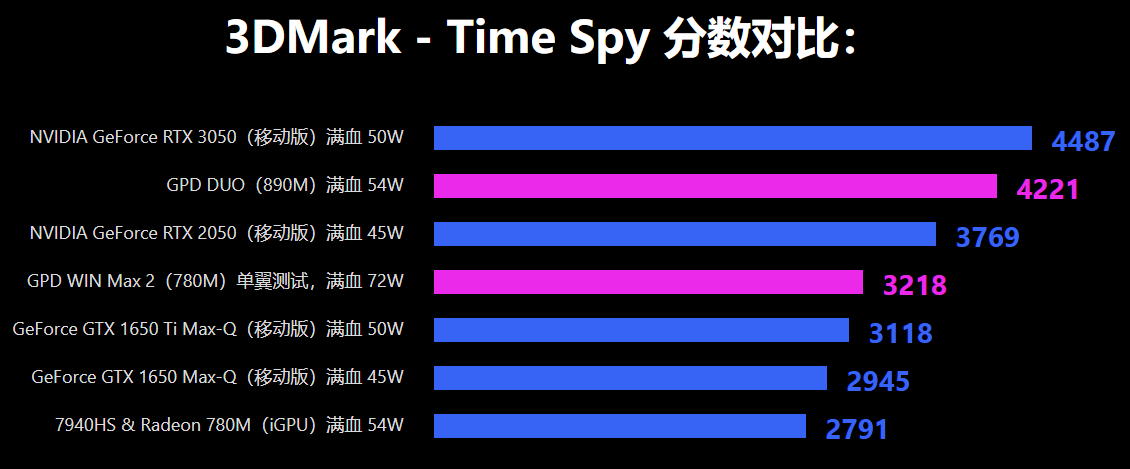In brief: For some time, curiosity has surrounded AMD’s upcoming Strix Point (Ryzen AI 300) APUs. Although the company expects to begin shipping the next-generation mobile processors as soon as next month, information on their performance has been scant so far. The first third-party vendor to publicly reveal performance projections for a Strix Point device is GPD, which seems quite optimistic.
The integrated graphics chip powering AMD’s Ryzen AI 300 SoCs might be substantially faster than the one currently used for most handheld gaming PCs if GPD’s official specs on its upcoming dual-screen laptop are anything to go by. The new APU lineup, also known as Strix Point, is expected to appear in a new generation of portable devices.
AMD unveiled the Ryzen AI 300 series at Computex earlier this month without saying much about its iGPUs – the Radeon 880M and 890M. They include 12 and 15 RDNA 3.5 compute units clocked at 2.9 GHz. For comparison, recent and upcoming handheld gaming PCs like the Asus ROG Ally, GPD Win 4, Zotac Zone, and XPG Nia, utilize their predecessor – the Ryzen 8040U series 780M – which includes 12 RDNA 3.0 CUs at 2.7 GHz.

According to leaker Golden Pig Upgrade Pack, MSI estimates that Ryzen AI 300 provides roughly 20 percent single-core, multi-core, and gaming performance improvement over the 8040U. That would come to about 3,600 points in 3DMark Time Spy – just under the Nvidia GeForce RTX 2050 or GTX 1650. However, mini-PC vendor GPD puts it notably higher.
The company recently revealed the hardware specs for the Duo, its upcoming dual-screen laptop. Although GPD’s English website states that the device packs an 8840U with a Radeon 780M, the Chinese site shows the same product with a Ryzen AI 9 HX 370 and an 890M. Furthermore, GPD has that iGPU achieving a Time Spy score of 4,221, easily topping the RTX 2050 and coming within spitting distance of the RTX 3050. Meanwhile, GPD’s AI 9 HX 370 showed a single-core score of 124 and a 1525 multi-core result in its Cinebench 2024 tests.

Although the 3DMark trial used wattages far beyond those in handheld PCs, they still suggest that Strix Point is significantly more powerful and energy efficient. While the 780M achieved a score of 3,218 at 72W, the 890M reached 4,221 on only 54W.
Time will tell if it maintains similar numbers in a portable gaming system, likely capped at 30W. The company initially teased the Duo as a 35W machine, but the full spec revealed that GPD revised the TDP to 60W. The thermal environment of a seven-to-eight-inch handheld would also be stricter than the 13.3-inch dual-screen notebook, which could impact real-world performance.

The GPD Duo features twin 60Hz 2880 x 1800 AMOLED touchscreens at a 255 PPI with 10-point touch control and Microsoft Pen Protocol support. While the bottom screen folds 135 degrees, the top panel bends 360 degrees for a two-in-one form factor. Additionally, it includes USB4 and OcuLink ports, up to 64GB of LPDDR5 RAM, and up to 4TB of internal SSD storage. However, a release date and price remain unclear.
Meanwhile, AMD’s Ryzen AI 9 HX 370 features 12 Zen 5 cores with a 5.1GHz maximum boost clock, 36MB of combined L2 and L3 cache, and an NPU capable of 50 TOPS. Red Team claims that Ryzen 9 AI outperforms recent AI PC hardware like the Qualcomm Snapdragon X Elite, Intel Core Ultra 185H, and Apple M3.

